
Chromodoris hamiltoni
Rudman, 1977
Order: NUDIBRANCHIA
Suborder: DORIDINA
Superfamily: EUDORIDOIDEA
Family: Chromodorididae
DISTRIBUTION
East Africa
PHOTO
UPPER RIGHT: Pangavini Is, off Kunduchi Bch, Dar es Salaam, Tanzania, 2 Nov 1976, 40mm long.
LOWER LEFT: Fungu Mkadya, off Kunduchi Bch, Dar es Salaam, Tanzania, 3 Jan 1974, 35mm long.
LOWER RIGHT: Fungu Yasin, off Kunduchi Bch, Dar es Salaam, Tanzania, 30 Nov 1976.
PHOTOS: Bill Rudman.
Usually a blue background colour but this can be very pale in some specimens. There are usually three thin dark blue black lines down the mantle but sometimes there can be extra lines and sometimes the inner lines can be replaced by broader diffuse brown or orange lines.
Reference:
•Rudman, W.B. (1977) Chromodorid opisthobranch mollusca from east Africa and the tropical West Pacific. Zoological Journal of the Linnean Society, 61: 351-397.
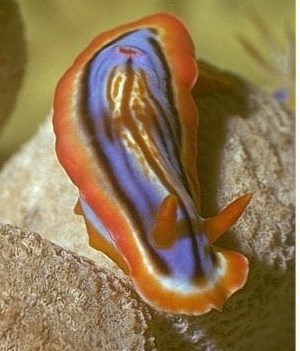
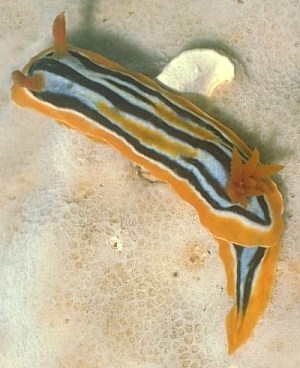
Rudman, W.B., 2000 (February 8) Chromodoris hamiltoni Rudman, 1977. [In] Sea Slug Forum. Australian Museum, Sydney. Available from http://www.seaslugforum.net/find/chrohami
Related messages
Chromodoris elisabethina? from South Africa
May 5, 2010
From: Henning Brodersen
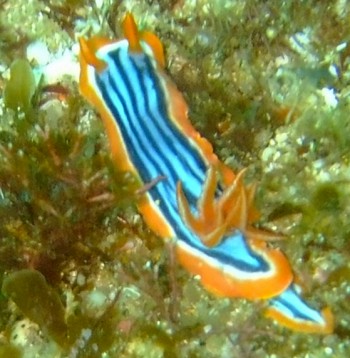
I found this Chromodoris in Aliwal Shoal. It looks very much like a C. elisabethina, but instead of 3 longitudinal stripes, this one has 5.
Maybe just a color variation?
Locality: Aliwal Shoal, 20 m, South Africa, Indian Ocean, 26 March 2010, Solid bottom. Length: 4-5 cm. Photographer: H. E. Brodersen.
Greetings from Denmark
Henning Brodersen
www.hbrodersen.dk
henning@hbrodersen.dk
Brodersen, H., 2010 (May 5) Chromodoris elisabethina? from South Africa. [Message in] Sea Slug Forum. Australian Museum, Sydney. Available from http://www.seaslugforum.net/find/23560Dear Henning,
This is almost certainly Chromodoris hamiltoni. It often has only three black lines but as you will see if your look through earlier messages on the Forum, five lines are not unusual, and sometimes some of them are partly brown.
Best wishes,
Bill Rudman
Chromodoris hamiltoni from Madagascar
May 21, 2009
From: Sully Bachel
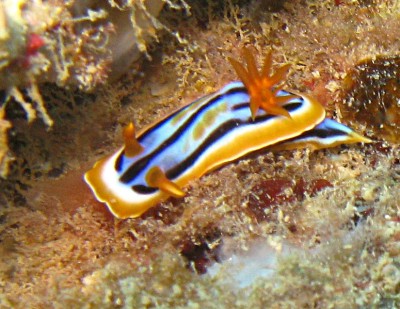
Concerning message #13284:
Hello Bill
I've found this nudibranch at Lakana Ile, Ste Marie, Madagascar. It looks like a Chromodoris hamiltoni but the blue background colour is very pale and I don't know if the central black line is a caracteristic of the species
Locality: Ste Marie island, 28 m, Madagascar, Indian Ocean, 20 October 2008. Length: 20 mm. Photographer: Sully Bachel.
Best regards
Sully
http://seaslugs.free.fr/index.htm
s.bachel@orange.fr
Bachel S, 2009 (May 21) Chromodoris hamiltoni from Madagascar. [Message in] Sea Slug Forum. Australian Museum, Sydney. Available from http://www.seaslugforum.net/find/22337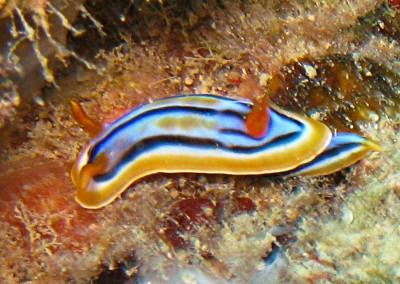
Dear Sully,
Yes this is C. hamiltoni. You will see on the Fact Sheet and animal very similar to yours in colour. In this species we sometimes find that some of the black lines are replaced by a diffuse orange-brown pigmentation. It also occurs in a few other species. We have no idea what causes this.
It is possible the animal is feeding on the orange-red sponge but I can't be sure from these photos.
Best wishes,
Bill Rudman
Chromodoris hamiltoni tasting? a hydroid.
September 10, 2008
From: Colin Ogden
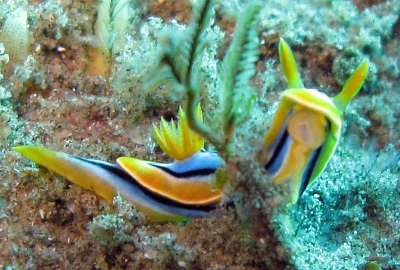

Hi Bill,
I couldn't resist sending you these photos together with the other photos of Chromodoris hamiltoni feeding on sponges [see #21875 ].
I was rather amused at this experimental nudi who actually tried to taste a hydroid. His reaction after tasting was rather human as he puckered his mouth to the unexpected sensation.
Locality: Sodwana Bay, 15 metres, South Africa, Indian, 11 April 2008, reef. Length: 25 mm. Photographer: Colin Ogden.
Regards
Colin
scubaco@iafrica.com
Ogden C. M., 2008 (Sep 10) Chromodoris hamiltoni tasting? a hydroid.. [Message in] Sea Slug Forum. Australian Museum, Sydney. Available from http://www.seaslugforum.net/find/21879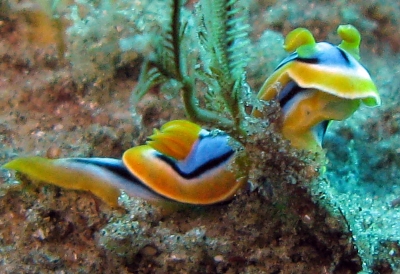
Dear Colin,
Very expressive body language! But very ironic - while we have great difficulty discovering what they like to eat, they certainly make it easy for us to know what they don't like to eat.
Best wishes & thanks,
Bill Rudman
Chromodoris hamiltoni feeding on black sponge? [2]
September 10, 2008
From: Colin Ogden
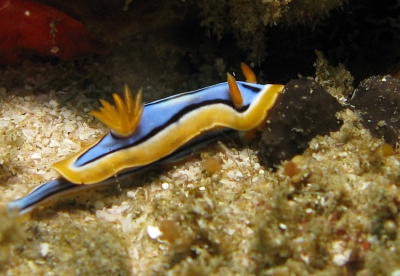
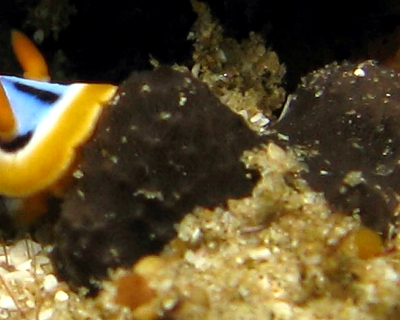
Hi Bill
Here is the fourth set of photos, also of Chromodoris hamiltoni showing extreme interest in black sponge.
Locality: Sodwana Bay, 15 metres, South Africa, Indian, 2008, reef. Length: 25 to 30 mm. Photographer: Colin Ogden.
Regards
Colin
scubaco@iafrica.com
Ogden C. M., 2008 (Sep 10) Chromodoris hamiltoni feeding on black sponge? [2]. [Message in] Sea Slug Forum. Australian Museum, Sydney. Available from http://www.seaslugforum.net/find/21878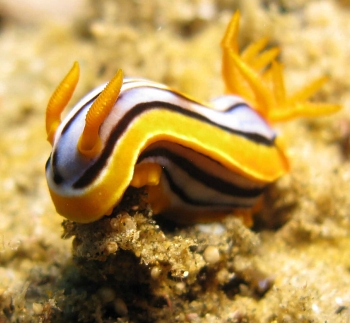
Dear Colin,
I am pretty sure this is a thorectid sponge of the genus Semitaspongia. This is a valuable contribution as it helps to confirm that C. hamiltoni feeds on two unrelated groups of sponges apparently attracted to particular anti-feedant molecules found in these sponges.
[For my general comments on Colin's series of sponge-feeding observations see the first message #21875].
Best wishes,
Bill Rudman
Chromodoris hamiltoni feeding on black sponge? [1]
September 10, 2008
From: Colin Ogden

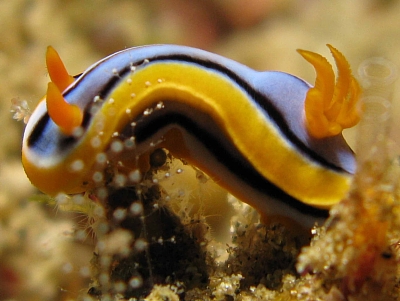
Hi Bill
Here are the third set of photos showing extreme interest, maybe feeding on a black sponge
Locality: Sodwana Bay, 15 metres, South Africa, Indian, 2008, reef. Length: 25 to 30 mm. Photographer: Colin Ogden.
Regards
Colin
scubaco@iafrica.com
Ogden C. M., 2008 (Sep 10) Chromodoris hamiltoni feeding on black sponge? [1]. [Message in] Sea Slug Forum. Australian Museum, Sydney. Available from http://www.seaslugforum.net/find/21877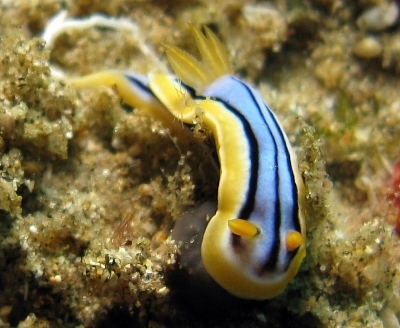
Dear Colin,
Yes I think we can say that these animals are more than just 'passing by', especially if we also consider Sylvain Le Bris's photo [#21555] showing an almost identical black 'siphon'. As I say in his message this is almost certainly a thorectid sponge perhaps Semitaspongia or Petrosaspongia. As we often find with this sponge, most of the colony is often covered in sand and debris.
[For my general comments on Colin's series of sponge-feeding observations see the first message #21875].
Best wishes,
Bill Rudman
Chromodoris hamiltoni feeding on orange sponge
September 10, 2008
From: Colin Ogden

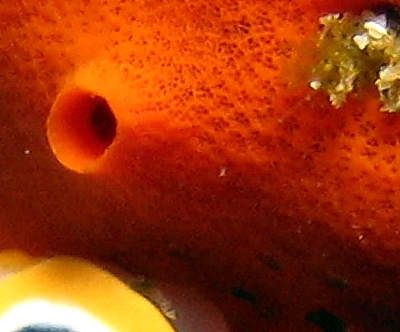
Hi Bill,
Here is the second set of photos of Chromodoris hamiltoni feeding - this time on an orange/red sponge.
Locality: Sodwana Bay, 15 metres, South Africa, Indian, 08 September 2008 and 30 Dec 2007, reef. Length: 20 mm. Photographer: Colin Ogden.
Colin Ogden
scubaco@iafrica.com
Ogden C. M., 2008 (Sep 10) Chromodoris hamiltoni feeding on orange sponge. [Message in] Sea Slug Forum. Australian Museum, Sydney. Available from http://www.seaslugforum.net/find/21876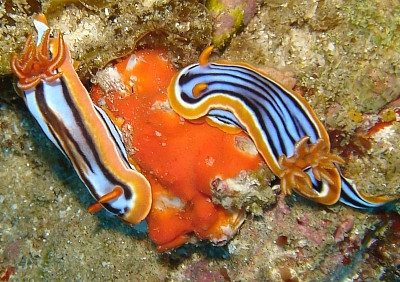
Dear Colin,
Thanks for these photos which we can treat as two more feeding records. The sponge in the upper photo is identical in structure to the one in Sylvain Le Bris's message [#21555], and I think we can presume the one in the lower photo is the same species. I think we can be pretty sure it is a species of Negombata, which as I discuss in your accompanying message [#21875], complements the earlier reports of the molecule latrunculin A in their mantle glands.
Best wishes,
Bill Rudman
Chromodoris hamiltoni feeding on various sponges
September 10, 2008
From: Colin Ogden

Concerning message #20503:
Hi Bill,
Recently I have been trying to collect some photos of Chromodoris hamiltoni feeding. I have some interesting ones that I would like to share with you. The first photos in this message show it feeding on a grey sponge. [See also messages #21876, #21877, #21878, #21879.]
Locality: Sodwana Bay, 15 metres, South Africa, Indian, 26 Nov 2007, reef. Length: 25 mm. Photographer: Colin Ogden.
Regards,
Colin
scubaco@iafrica.com
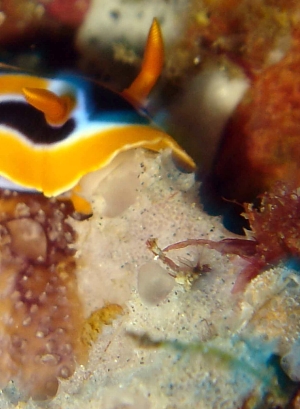

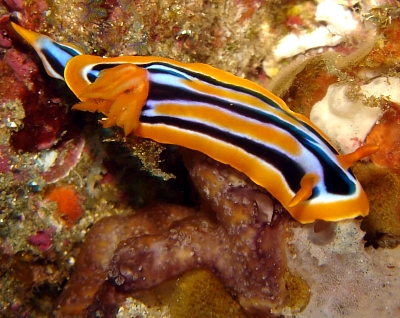
Dear Colin,
Thanks very much for this series of photos. I'll discuss the significance of all these records here rather than spread the story thinly over the other messages. Firstly, the photos in this message show C. hamiltoni feeding on a sponge which clearly includes sand grains in its skeletal structure, which suggests it is either a thorectid or the related family Irciniidae. This seems to be a different species to the greyish black thorectids already reported for this species, so adds to the accumulating knowledge on the biology of this species.
When I published the review on chromodorid feeding last year (Rudman & Bergquist, 2007), the only thing we knew about the food of C. hamiltoni was from a scientific article by Pika & Faulkner (1995) reporting the presence of chemicals in the skin, and spicules in the stomach, typical of the bright red sponge Latrunculia [which is now considered to be a species of Negombata]. Although this is an unusual sponge for chromodorids to feed on, we now know that a number of similarly coloured species, such as C. quadricolor, also feed on species of Negombata, and also on blackish species of quite unrelated dictyoceratid sponges of the family Thorectidae. It seems this group of chromodorids have chosen these sponges because of the presence of powerful antifeedant molecules called latrunculins, which are found in both sponge groups. In the last year we have had messages to the Forum suggesting C. hamiltoni possibly feeds on another thorectid similar to Phyllospongia [#20503 ] and two messages associating C. hamiltoni with both the red Negombata and a dark grey thorectid, possibly Petrosaspongia or Semitaspongia [messages #20505; 21555]. Your messages confirm feeding on Negombata [#21876], and a dark grey thorectid [#21877; [#21878 ]. In summary, these records of yours are a valuable addition to our knowledge of the natural history of this species.
When the two scientific papers listed below were published, the chemicals found in C. hamiltoni were very puzzling as they did not fit the normal pattern which was emerging for species of Chromodoris. Now that we know that there is a group of species which 'break the rules', evidence such as yours, showing just what sponges are eaten by this nudibranch, are showing us that there is a pattern to their food choice, but it is a little more complicated than we first thought.
- McPhail, K. & Davies-Coleman, M.T. (1997) New spongiane diterpenes from the East African Nudibranch Chromodoris hamiltoni. Tetrahedron, 53(13): 4655-4660
- Pika, J. & Faulkner, D. J. (1995) Unusual chlorinated Homo-Diterpenes from the South African nudibranch Chromodoris hamiltoni. Tetrahedron, 51, 8189–8198.
- Rudman, W. B. & Bergquist, P. R. (2007) A review of feeding specificity in the sponge-feeding Chromodorididae (Nudibranchia: Mollusca). Molluscan Research, 27(2): 60-88.
Best wishes,
Bill Rudman
Chromodoris hamiltoni? from South Africa
May 1, 2008
From: Sylvain Le Bris
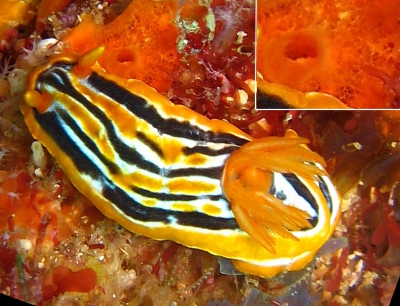

Concerning message #20569:
Hi Bill,
Are these species color variation of Chromodoris hamiltoni?
Locality: Sodwana Bay, 15 m, South Africa, Indian Ocean, April 2008. Photographer: Sylvain Le Bris.
Regards
Sylvain
lebris.sylvain@gmail.com
Le Bris, S., 2008 (May 1) Chromodoris hamiltoni? from South Africa. [Message in] Sea Slug Forum. Australian Museum, Sydney. Available from http://www.seaslugforum.net/find/21555
Dear Sylvain,
Yes these are all forms of C. hamiltoni. In an earlier message [#20568] I mentioned how we had no direct evidence on what sponge this species ate. I suggested it was probably a bright red-orange species of Negombata because that genus had a molecule called latrunculin which was also found in C. hamiltoni. The full story is that there is a quite unrelated group of grey-black sponges in the genus Petrosaspongia and possibly Semitaspongia which also have this chemical.
One of your photos shows a bright red sponge, and another shows a grey-black sponge almost completely hidden under a layer of sand. I can't say they are feeding on either of the sponges but it is the closest we have come so far. If C. hamiltoni does eat both sponges it would be an exciting parallel to the the look-alike C. quadricolor which we now know does precisely that [see message #20150]. So at the risk of sounding like a squeaky wheel, any eating observations would be very welcome.
Best wishes,
Bill Rudman
Re: More Chromodoris hamiltoni from Tofo, Mozambique
April 28, 2008
From: Colin Ogden
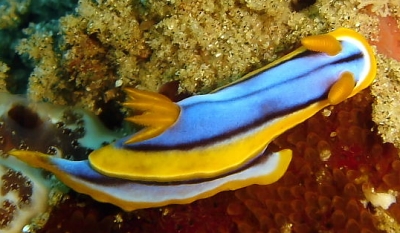
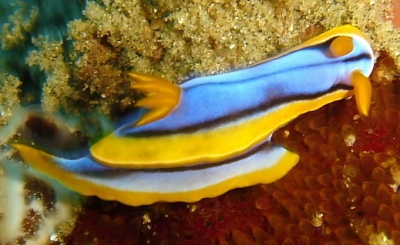
Concerning message #20547:
Hi Bill,
following Natasja's message on Chromodoris hamiltoni I found this animal on a dive that seemed also to have either a split tail, or was on top of another nudi. The other photos I took showed that it was either damage or an abnormality to its foot. Tofo, where Natasja got her pictures is not too far from Sodwana Bay.
Locality: Sodwana Bay, 18 metres, South Africa, Indian, 20 August 2007, Reef. Length: 45mm. Photographer: Colin Ogden.
Regards
Colin
scubaco@iafrica.com
Ogden C M, 2008 (Apr 28) Re: More Chromodoris hamiltoni from Tofo, Mozambique. [Message in] Sea Slug Forum. Australian Museum, Sydney. Available from http://www.seaslugforum.net/find/20582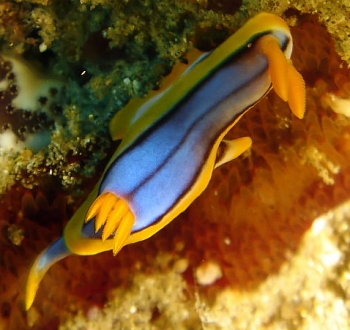
Dear Colin,
It is certainly a strange abnormality. I suspect it is through physical damge rather than developmental abnormality but that's just a guess.
Best wishes,
Bill Rudman
Orange form of Chromodoris hamiltoni
April 28, 2008
From: Colin Ogden
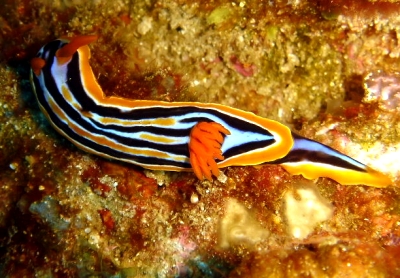
Hi Bill,
As discussed in my previous message [#20568] this is the orange form of the Chromodoris hamiltoni we encounter on our reefs. (there are many variations within this as well)
Locality: Sodwana Bay, 14 metres, South Africa, Indian, various, reef. Length: 50 mm. Photographer: Colin Ogden.
Regards
Colin
scubaco@iafrica.com
Ogden C.M., 2008 (Apr 28) Orange form of Chromodoris hamiltoni. [Message in] Sea Slug Forum. Australian Museum, Sydney. Available from http://www.seaslugforum.net/find/20569Dear Colin,
Although it looks a bit more slender than more typical specimens I assume that is just the way it was crawling along when photographed. In colour it looks very like the animal in the bottom left photo on the Fact Sheet
Best wishes,
Bill Rudman
Variations in Chromodoris hamiltoni
April 28, 2008
From: Colin Ogden
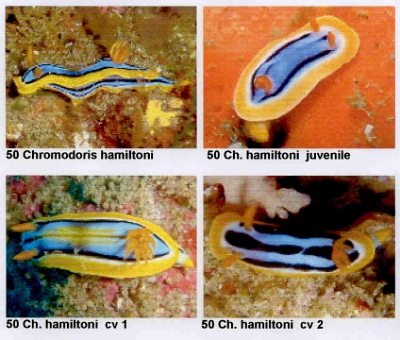
Hi Bill,
Following all the discussion about Chromodoris hamiltoni, I have prepared pictures of all the variations on C. hamiltoni we see here. I have put all the predominantly blue ones on this sheet, and will send a separate message of the orange form [#20569 ].
C. hamiltoni is probably the most often encountered nudi here. In fact on one of our dives today we must have seen at least 40 separate individuals.
The differences are as follows - see names on the photos:
Chromodoris hamiltoni - most consistent form
Ch. hamiltoni juvenile and cv 7 are both juveniles though the middle black line on cv7 is much stronger than on the first juvenile. Both have a pronounced inner white border to their mantle.
cv1 has an orange section surrounded by blue on its mantle.
cv2 has much thicker black markings. (I at first thought it might be a C. strigata, and I still have doubts on it being C. hamiltoni at all but it was slightly smaller that the normal fully grown adult C. hamiltoni )
cv3 has a "washed out" orange border to its mantle.
cv4 has more black lines than normal, and a good white inner ring on its mantle.
cv5 adult with a good white inner ring.
cv6 darker section between the black lines on its back.
cv8 mottled blue on its back.
cf. hamiltoni different colour almost peach colour rather than orange edge to its mantle.
The other 2 are of a melanistic form.
Locality: Sodwana Bay, 10 to 30 metres, South Africa, Indian, various, reef. Length: 10 mm to 50mm. Photographer: Colin Ogden.
Regards
Colin
scubaco@iafrica.com
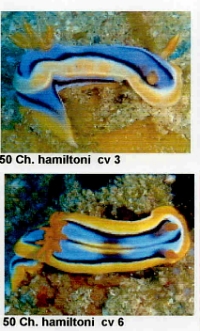
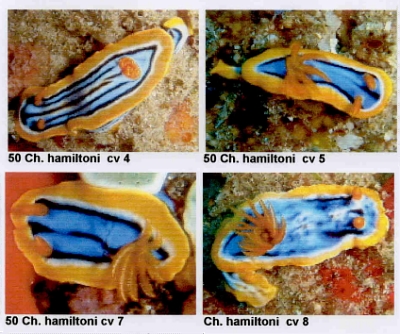
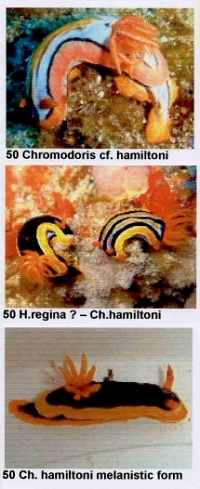
Dear Colin,
Thanks for this comprehensive collection. In Tanzania Chromodoris hamiltoni often had an orange patch in the middle of the back and often the middle part of the black lines were orange instead of black. I also saw animals with the 'peach' coloured border as in your cf. hamiltoni.
I have some doubts about the ones you have doubts with ie; Ch. hamiltoni juvenile, cv 2, cv 7., but I am afraid I can't make any sensible comments other than 'gut feelings' are often worth following up.
Concerning the 'melanistic' ones. I have discussed these previously - and changed my mind [see message #18677]. I initially thought they were melanistic C. hamiltoni but later, on the basis of some other photos from Erwin Koehler, and some on their food sponge, I came to the conclusion they were melanistic Hypselodoris regina. Since we have no actual observations of C. hamiltoni feeding on any sponge I am still open to changing my mind again if you can find 'good' C. hamiltoni feeding on a this dysideid sponge. While most species of Chromodoris feed on darwinellid sponges, C. hamiltoni, in colour at least, belongs to a group of species which shows a rather unusual choice of food sponges. So what I am trying to say I guess is can you look out for C. hamiltoni feeding please. I realise that it is often the most common species which are the most difficult to find feeding - I know that sounds strange but there seems to be some inverse law of nature which says that the more common a species is the more difficult it is to find it 'doing things'.
The only clues I can give you is that Pika & Faulkner (1995) and McPhail & Davies-Coleman (1997) both recorded finding chemicals in C. hamiltoni which are almost certainly from bright red sponges of the genus Negombata.
- McPhail, K. & Davies-Coleman, M.T. (1997) New spongiane diterpenes from the East African Nudibranch Chromodoris hamiltoni. Tetrahedron, 53(13): 4655-4660
- Pika, J. & Faulkner, D. J. (1995) Unusual chlorinated Homo-Diterpenes from the South African nudibranch Chromodoris hamiltoni. Tetrahedron, 51, 8189–8198.
Best wishes,
Bill Rudman
Re: More Chromodoris hamiltoni from Tofo, Mozambique
August 29, 2007
From: Natasja Vandeperre
Concerning message #20547:
Dear Bill,
These are indeed two different animals.
Best wishes,
Natasja
postmaster@naaktslakken.be
Natasja Vandeperre, 2007 (Aug 29) Re: More Chromodoris hamiltoni from Tofo, Mozambique. [Message in] Sea Slug Forum. Australian Museum, Sydney. Available from http://www.seaslugforum.net/find/20578Thanks Natasja,
Best wishes,
Bill Rudman
More Chromodoris hamiltoni from Tofo, Mozambique
August 26, 2007
From: Natasja Vandeperre
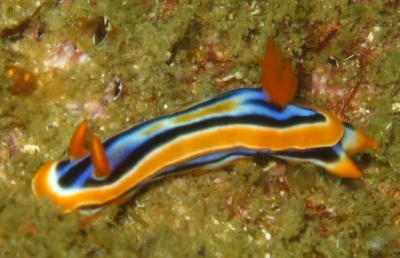
Dear Bill,
Some more pictures of Chromodoris hamiltoni.
Locality: Tofo, Mozambique, Indian Ocean, 22 July 2007. Length: 30 mm. Photographer: Natasja Vandeperre.
Greetings,
Natasja
postmaster@naaktslakken.be
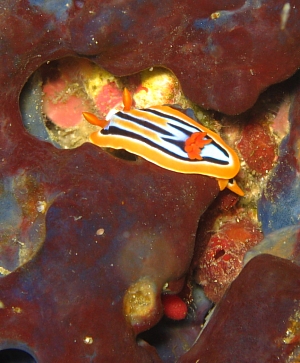
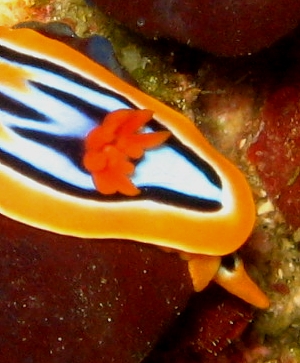
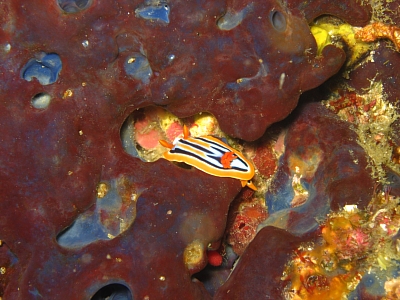
Dear Natasja,
Thanks for these photos. Are they two different animals or the same one? Why I ask is I can see that both animals seem to have a split 'tail', which is something I have not seen before in chromodorids, so I am surprised to see it in two animals. The orange lines on the mantle seem to be different in the two photos so it certainly seems to be two animals.
The animal in the lower photo is associated with the same two sponges, the brownish thorectid and the bright red Negombata present in your earlier message [#20505]. Again unfortunately there is no evidence of feeding
Best wishes,
Bill Rudman
Another Chromodoris hamiltoni from Tofo, Mozambique
August 22, 2007
From: Natasja Vandeperre
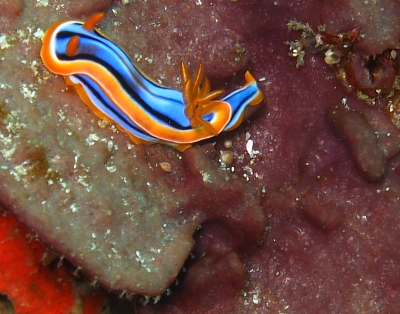
Hello Bill,
Here is another specimen of Chromodoris hamiltoni from Tofo, Mozambique.
Locality: Tofo, Mozambique, Indian Ocean, 20 July 2007. Photographer: Natasja Vandeperre.
Best wishes,
Natasja
postmaster@naaktslakken.be
Vandeperre, N., 2007 (Aug 22) Another Chromodoris hamiltoni from Tofo, Mozambique. [Message in] Sea Slug Forum. Australian Museum, Sydney. Available from http://www.seaslugforum.net/find/20505
Dear Natasja,
This photo illustrates the sponges I was talking about in your earlier message [#20503]. The greyish brown one looks like the thorectid in the earlier message, and the bright red one is almost certainly a species of Negombata, which is what I said C. hamiltoni has been reported to feed on previously.
In your last message the partially everted oral tube was pretty convincing evidence that the animal was feeding on a thorectid, but in this photo I could mount a case for either, or both, species being its food item. However, apart from close proximity we can't say this photo is proof of C. hamiltoni eating either sponge. Very tantalising.
Best wishes,
Bill Rudman
Chromodoris hamiltoni feeding? from Mozambique [1]
August 22, 2007
From: Natasja Vandeperre

Dear Bill,
Here's a picture of Chromodoris hamiltoni. Is it feeding?
Locality: Tofo, Mozambique, Indian Ocean, 20 July 2007. Photographer: Natasja Vandeperre.
Greetings,
Natasja
postmaster@naaktslakken.be
Vandeperre, N., 2007 (Aug 22) Chromodoris hamiltoni feeding? from Mozambique [1]. [Message in] Sea Slug Forum. Australian Museum, Sydney. Available from http://www.seaslugforum.net/find/20503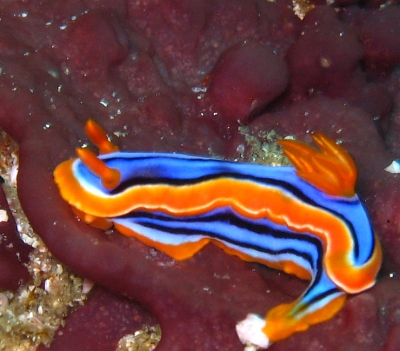
Dear Natasja,
The animal seems to have an orange oral tube partly everted so I suspect it is feeding. If so, this is an interesting observation because the only previous observation we have of this species feeding is on a bright red sponge Negombata. But we also know that some of the chromodorids that feed on Negombata also feed on thorectid sponges as well, and this sponge is almost certainly a thorectid. This could be a useful little piece in the jigsaw puzzle.
Best wishes,
Bill Rudman
Chromodoris hamiltoni & C. quadricolor near Pemba?
April 17, 2006
From: Rob Veelenturf

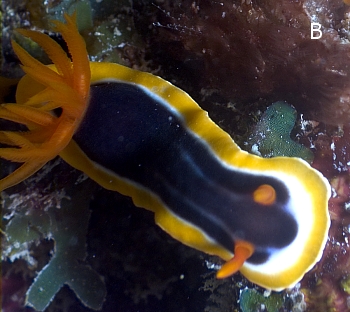
Dear Bill,
On a dive near Pemba I saw these two fellows. I guess they are both Chromodoris hamiltoni, but the one in the front is quite dark. What do you think?
Locality: Pemba, 20 metres, Tanzania, Indian Ocean, 05 March 2006. Photographer: Rob Veelenturf.
Best Regards,
Rob Veelenturf
rob@cv-design.com
Veelenturf R., 2006 (Apr 17) Chromodoris hamiltoni & C. quadricolor near Pemba?. [Message in] Sea Slug Forum. Australian Museum, Sydney. Available from http://www.seaslugforum.net/find/16372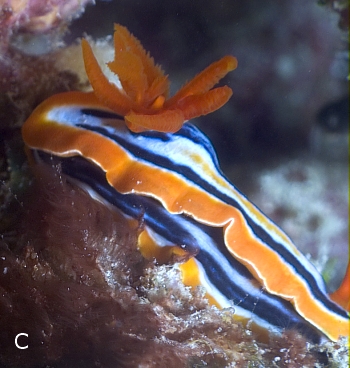
Dear Rob,
You have two species here. I have split your photo in two so there is no mistake which is which. The dark one [Photo B] is Chromodoris quadricolor and the brighter on [Photo C] is C. hamiltoni. The colour of both species is almost identical to photos of mine you will find on the Fact Sheets of each of these species from near by Dar es Salaam.
They are certainly very similar in colour but this seems to be a defensive strategy quite a few species of chromodorids have adopted [see aposematic colouration Fact Sheet]
Best wishes,
Bill Rudman
Chromodoris elisabethina from South Africa
April 22, 2005
From: Riaan Marx
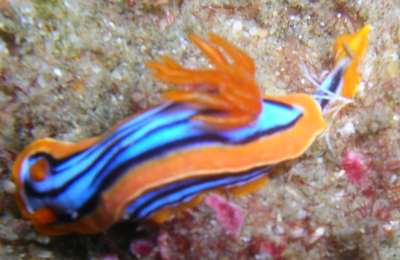
Hi Dr. Rudman,
I have photographed this specimen on 7-mile reef, Sodwana bay, South Africa. I see from the fact file on the species that you mention the Indian ocean is a possible location for them, well unless I have incorrectly identified this critter, we have our proof.
Locality: 7 Mile reef, Sodwana Bay, South Africa, Indian Ocean. Depth: 21 m. Length: 30-35 mm. 15 Apr 2005. Rocky Coral. Photographer: Riaan Marx
Kind regards,
Riaan
v-riaanm@microsoft.com
Marx, R., 2005 (Apr 22) Chromodoris elisabethina from South Africa. [Message in] Sea Slug Forum. Australian Museum, Sydney. Available from http://www.seaslugforum.net/find/13585Dear Riaan,
As you'll see from earlier messages there is some confusion over some of these black-lined chromodorids. Your animal looks very like what I would call Chromodoris hamiltoni. One of the obvious colour differences is that in C. elisabethina there is a white band between the orange mantle margin and the outer black line while in C. hamiltoni there is usually not. However the situation is complicated by the possibility of another species as discussed by Bernard Picton in an earlier message [#4745]. One thing the Forum has done is complicate some of the more simplistic ideas we had in the past, based on fewer records. This may be an annoyance now when we try to neatly 'name' things, but in the longterm it will give us a much better understanding of what is going on.
Best wishes,
Bill Rudman
Chromodoris hamiltoni from Reunion Island
March 9, 2005
From: Philibert Bidgrain

Dear Bill,
Reunion Island sea slugs.
We have this specimen, observed by Drivas. It seems evident that is a Chromodoris, but I have some doubts about the species : C. strigata, C. hamiltoni or C. elisabethina, ...
What do you think about is ID?
Best Regards
Philibert Bidgrain
http://vieoceane.free.fr/runseaslug/indexslug.htm
pbidgrain@yahoo.fr
Bidgrain, P., 2005 (Mar 9) Chromodoris hamiltoni from Reunion Island. [Message in] Sea Slug Forum. Australian Museum, Sydney. Available from http://www.seaslugforum.net/find/13284Dear Philibert,
Sometimes its very hard to be sure, and the photo doesn't help that much. My best guess is that is C. hamiltoni .
Best wishes,
Bill Rudman
Chromodoris hamiltoni from Mozambique
January 28, 2005
From: Charles Rowe
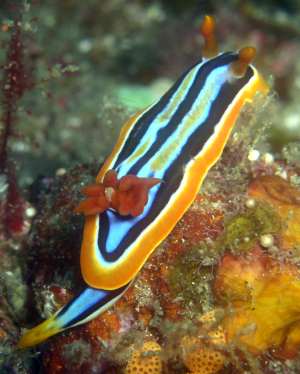
Hi Bill,
As promised here is a photo of a nudi I would like identified.
Dereks Reef - Ponto Malongame, Mozambique, 26 November 2004, 20
metres
The Mozambique trip was great but such a long drive!
See ya.
Charles.
Charles.rowe@gmsa.com
Rowe, C., 2005 (Jan 28) Chromodoris hamiltoni from Mozambique. [Message in] Sea Slug Forum. Australian Museum, Sydney. Available from http://www.seaslugforum.net/find/13047Dear Charles,
This is Chromodoris hamiltoni. It's nice to get a record from Mozambique - it closes the gap between South Africa and Tanzania.
Best wishes,
Bill Rudman
Chromodoris hamiltoni from Sodwana
October 8, 2003
From: Charles Rowe
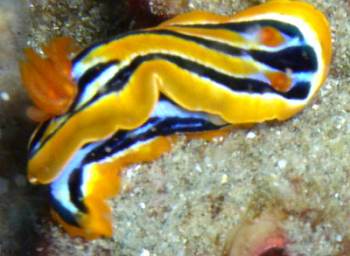
Dear Bill,
Weather was bad for diving so here is another photo I have looked out for you to identify, It was taken at Antons Reef, Sodwana, South Africa on 5 January 2003 in 16 metres.
Charles Rowe
bumff@mweb.co.za
Rowe, C., 2003 (Oct 8) Chromodoris hamiltoni from Sodwana. [Message in] Sea Slug Forum. Australian Museum, Sydney. Available from http://www.seaslugforum.net/find/11150Thanks Charles,
This is Chromodoris hamiltoni, which is quite common further north on the tropical east African coast. It is apparently not uncommon on the northeast coast of South Africa as well.
Best wishes
Bill Rudman
Chromodoris hamiltoni from Pemba
November 18, 2002
From: Paul Young

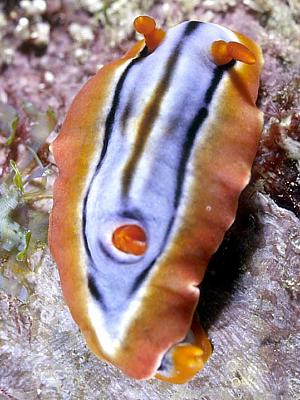
Dear Bill,
Here is another of the nudibranchs that Charlotte and I found at Pemba Island, off the coast of Tanzania, western Indian Ocean, in November/December 2001.
Upper Image: Seen 28, 29 November, East side of Pemba
Lower Image: 29 November, East side of Pemba, night dive
Best wishes,
Paul Young
young@underwater.org
Young, P., 2002 (Nov 18) Chromodoris hamiltoni from Pemba. [Message in] Sea Slug Forum. Australian Museum, Sydney. Available from http://www.seaslugforum.net/find/8415Thanks Paul,
This is Chromodoris hamitoni which is, at present, known only from the western Indian Ocean. These two animals show an interesting colour variation which is not uncommon in this species. The orange can become quite reddish and parts of the black lines can become orange or brown. This colour variability seems to occur in similarly coloured species from the western Pacific, but we still need to understand the species limits better before we know if we are arguing in circles or not
Best wishes,
Bill Rudman
Chromodoris hamiltoni from South Africa
May 21, 2002
From: Linda Penny
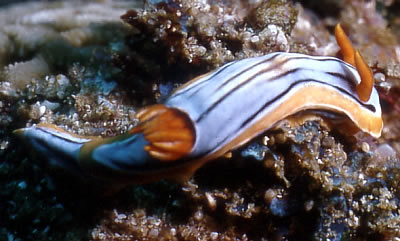
Dear Bill,
Firstly, thank you so much for an excellent site. Being a novice photographer and nudibranch enthusiast, your site has been invaluable in identifying our finds. This nudibranch however has us stumped. It is photographed quite often in South African waters off Sodwana and slightly higher in Mozambique and looks like a Chromodoris elisabethina but our one always has a double white marking down the back. I also thought it might be Chromodoris annae but again, the white marks are missing. I would appreciate your expertise.
Many Thanks
Linda
lindapenny@netactive.co.za
Penny, L., 2002 (May 21) Chromodoris hamiltoni from South Africa. [Message in] Sea Slug Forum. Australian Museum, Sydney. Available from http://www.seaslugforum.net/find/6965Dear Linda,
This is Chromdoris hamiltoni which at present is known only from the western Indian Ocean. In another message on the Forum today I discuss the dangers of mixing sea slugs and large anemones in aquaria and mention I lost a new species down the stomach of an anemone. It was in fact the first specimen I found of Chromodoris hamiltoni.
I would be happy to hear of any intersting finds and observations you make, even of animals you have been able to identify. In science, a second or third sighting of something is not 'old news' but valuable confirmation of earlier information.
Best wishes,
Bill Rudman
Chromodoris hamiltoni from east Africa
July 5, 2001
From: Bernard Picton
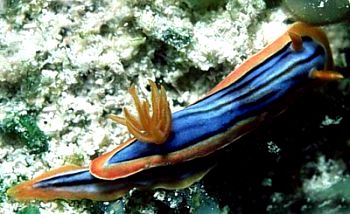
Hi Bill,
Here are some scans of Chromodoris hamiltoni from Pemba Island, Tanzania, Feb 1999. I saw about ten animals of this species altogether and these photos indicate the range of variation in that population at that time. Notably the black markings on the blue background seemed to be blurred at the edges, making them look 'out of focus'. The variation of markings was not very wide, making me question whether the variety which you illustrate at bottom right on the web page and which Valda Fraser sent on February 11,
2000 is really the same species.
Given that selection pressures are strong enough to produce such a good mimic as Hypselodoris regina I wonder if there is another species here, indeed is it the same as Chromodoris cf. colemani? I have sent three scans of these from the Philippines in a separate message but on looking through other pictures I have from Philippines and Bali there seems to be a series linking these entities. I'll send a couple of other photos tomorrow.
Bernard
bernard.picton.um@nics.gov.uk
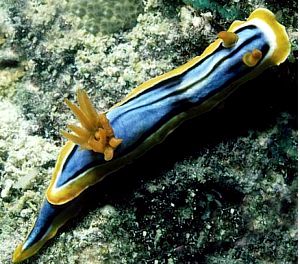
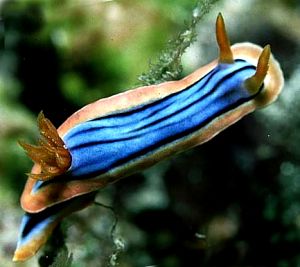
Thanks Bernard,
It's good to see my old friend, C. hamiltoni from Tanzania again and gald that you also think it is a good species. At times when I am puzzling over this Chromodoris cf. colemani and Chromodoris cf. africana group I wonder just where one species ends an another begins. I named C. hamiltoni after my first graduate student, Hamish Hamilton, who was tragically killed in an accident 2 days before his graduation ceremony so I hope it survives any taxonomic shake up.
Concerning these animals with brown lines. In some cases, as in some specimens of C. hamiltoni the orange-brown lines seem to replace the normal black lines, while in others, including C. colemani the orange-brown lines seem to be a normal part of the colour pattern. It seems that the first step in sorting this group out is determining in which cases the orange-brown line is just replacing a 'normal' black line and in which cases it is itself the 'normal' colour.
Best wishes,
Bill Rudman
Pale version of Chromodoris hamiltoni?
May 6, 2000
From: Valda Fraser
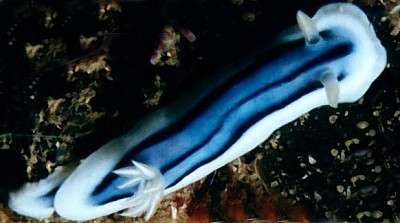
Dear Bill
Diving in a new area I saw plenty of these nudibranchs. The pale gills and mantle edge ... something which I have not seen before.
Do you know what they are? I hope you will be able to solve the identification problem.
Thanks.
Locality: South coast KwaZulu-Natal, SOUTH AFRICA. Scottburgh - 15m
Date: April 2000
Size: 25mm
Regards
Valda Fraser
iti04937@mweb.co.za
Fraser, V., 2000 (May 6) Pale version of Chromodoris hamiltoni?. [Message in] Sea Slug Forum. Australian Museum, Sydney. Available from http://www.seaslugforum.net/find/2328Dear Valda,
I think I would need to see some animals. My first thought was a form of Chromodoris lochi but on reflection I think this is probably a pale form of Chromodoris hamiltoni. If you gave the pale areas (mantle border, gills, rhinophores) some orange then you would have a fairly typical Chromodoris hamiltoni.
But I would need to check the anatomy to be sure.
Best wishes,
Bill Rudman.
Chromodoris hamiltoni? from South Africa
May 5, 2000
From: Valda Fraser
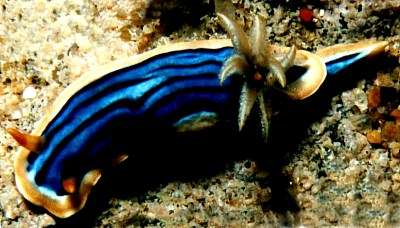
Dear Bill
This nudibranch is puzzling me. I hope you have some ideas. Thanks.
Locality: South Coast KwaZulu-Natal, SOUTH AFRICA. Scottburgh - 15m
Date: April 2000
Size: 30mm
Regards
Valda Fraser
iti04937@mweb.co.za
Fraser, V., 2000 (May 5) Chromodoris hamiltoni? from South Africa. [Message in] Sea Slug Forum. Australian Museum, Sydney. Available from http://www.seaslugforum.net/find/2327Dear Valda,
I am pretty sure this is Chromodoris hamiltoni but it seems to differ in having a submarginal orange border - but that could be an artifact of photography. It also differs in having white gills edged with orange.
However there seems to be an intermediate example from South Africa in Valda's earlier message, which would suggest this is C. hamiltoni. It would howver be worth keeping an eye out for consistent colour differences - particular in the gill colour.
Best wishes,
Bill Rudman.
Colour variation in Chromodoris hamiltoni
February 14, 2000
From: Valda Fraser

Dear Bill
Following your comment on colour variation in this species, the "blue" type of Chromodoris hamiltoni occurs in large numbers along the south coast of KwaZulu-Natal. The intensity of the blue colouring is variable.
Locality: South Coast KwaZulu-Natal, South Africa. Hibberdene.
Date: March 1999
Size: 45mm
Regards
Valda Fraser
iti04937@mweb.co.za
Fraser, V., 2000 (Feb 14) Colour variation in Chromodoris hamiltoni. [Message in] Sea Slug Forum. Australian Museum, Sydney. Available from http://www.seaslugforum.net/find/1891Dear Valda,
Thanks for the record. Your blue animal makes me feel happier about my identification. It would be nice to know if the different black-lined species ate (or were found on) different sponges, and whether they had different egg masses (colour? size of eggs? shape?).
Best wishes,
Bill Rudman.
Chromodoris hamiltoni from South Africa
February 11, 2000
From: Valda Fraser
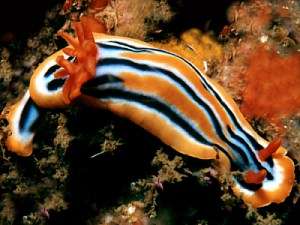
Dear Bill
I have found another nudibranch which I am unable to identify. I saw three specimens a couple of metres apart. Please help!
Locality: South Coast KwaZulu-Natal, SOUTH AFRICA. Park Rynie - 25m
Date: 13 February 2000
Size: 65mm
Regards
Valda Fraser
iti04937@mweb.co.za
Fraser, V., 2000 (Feb 11) Chromodoris hamiltoni from South Africa. [Message in] Sea Slug Forum. Australian Museum, Sydney. Available from http://www.seaslugforum.net/find/1878Dear Valda,
Although your animal has more white than blue in its colour pattern I am pretty sure it is
Chromodoris hamiltoni. As you can see that species varies in the number of black lines on its mantle and is one of a few species in which the black line can be replaced by a broader somewhat diffuse orange or brown line.
All I can say is keep an eye out for colour variation and collect some specimens. Compare with H. regina which you recently sent to the Forum. When I get a moment I will prepare a page on the Chromodoris quadricolor Colour Group so it will be easier to compare all these similarly coloured black-lined species.
Best wishes,
Bill Rudman.
